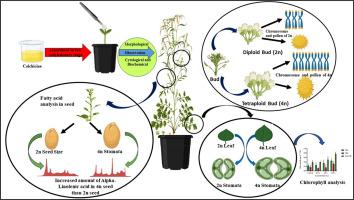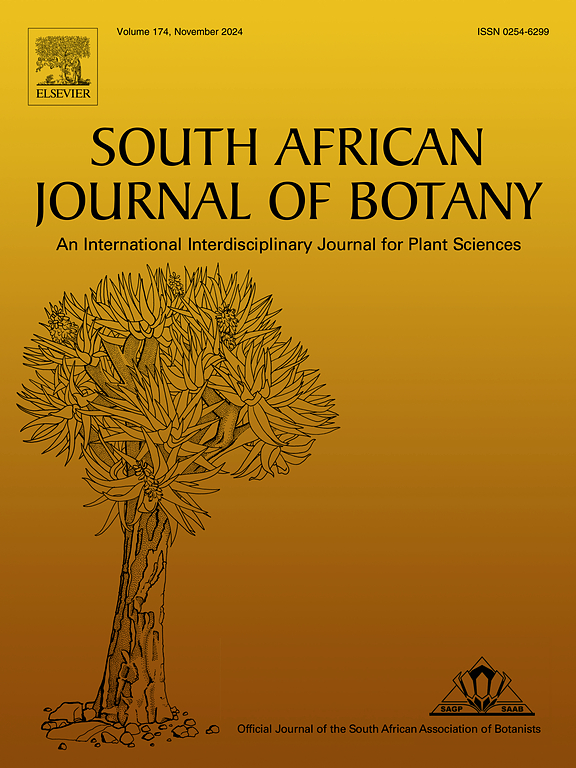秋水仙碱处理及多倍体诱导对莴苣形态、生化及细胞学特性的影响
IF 2.7
3区 生物学
Q2 PLANT SCIENCES
引用次数: 0
摘要
人类依靠植物获得食物、燃料、住所和药物。药用植物具有特殊的药用分子。为了提高这些特定植物的理想性状,多倍体诱导是一种极好的育种技术,可以改变基因组的倍性水平,从而提供与正常植物相比在不利环境下生存的能力。因此,本研究的目的是获得淫羊藿同源四倍体。它们被广泛用于治疗呼吸系统疾病的传统药物中。它富含类黄酮和硫代葡萄糖苷等具有抗炎特性的化合物。总的来说,它对健康有益,主要是维持免疫系统、骨骼和心血管健康。下降方法的实验是由真正的年轻的两扇阶段幼苗不同浓度的秋水仙素处理(0.2,0.4,0.5%)持续时间24小时,48 h,和72 h。多倍体诱导的形式被发现形态学变化如叶片长度、叶片厚度、叶片宽度气孔大小、气孔密度、花蕾大小、豆荚大小、种子大小、种子重量,花粉直径,细胞学参数包括与二倍体植物相比,四倍体植物的基因组加倍。将观察到的同源四倍体培养到完全成熟,并通过气相色谱-质谱(GC-MS)对收获的种子进行分析,结果显示脂肪酸等生化物质的百分比增加。由于植物的生长和发育受到多倍体的影响,植物育种利用染色体加倍来增加所需化学物质的数量,并且已经观察到同样的情况,从而产生了一个潜在的栽培品种Lepidium sativum Linn。产量提高,适应性好。本文章由计算机程序翻译,如有差异,请以英文原文为准。

Effect of colchicine treatment and polyploidy induction on morphological, biochemical, and cytological characteristics of Lepidium sativum Linn․
Humans rely on plants for food, fuel, shelter, and medicine. Medicinally important plants possess exceptional molecules with medicinal purposes. To enhance the desirable traits of these particular plants, polyploidy induction is an excellent breeding technique altering the ploidy level of the genome, providing the ability to survive in adverse circumstances compared to normal plants. Thus, the present research aimed to obtain the autotetraploids in Lepidium sativum Linn. that are widely used in traditional medicines to treat respiratory disorders. It is rich in compounds such as flavonoids and glucosinolates that possess anti-inflammatory properties. Overall, it is beneficial for health, mainly in maintaining the immune system, bones, and cardiovascular health. The experiment was performed by the dropping method in true two-leaf stages of the young seedlings treated with different concentrations of the colchicine (0.2, 0.4, and 0.5%) for the durations 24 h, 48 h, and 72 h. The polyploidy induction was found to be in the form of morphological variations such as leaf length, leaf thickness, leaf breadth stomata size, stomata density, bud size, pod size, seed size, seed weight, pollen diameter, and cytological parameters including doubling of the genome within tetraploid plants in comparison to diploid plants. The observed autotetraploids were grown up to full maturity, and harvested seeds were analyzed via gas chromatography mass spectrometry (GC–MS), showing an increased percentage of biochemicals such as fatty acids. Because the growth and development of plants are influenced by polyploidization, plant breeding has used chromosome doubling to boost the amounts of desired chemicals, and the same has been observed, resulting in a potential cultivar of Lepidium sativum Linn. with an increased yield and better adaptability.
求助全文
通过发布文献求助,成功后即可免费获取论文全文。
去求助
来源期刊

South African Journal of Botany
生物-植物科学
CiteScore
5.20
自引率
9.70%
发文量
709
审稿时长
61 days
期刊介绍:
The South African Journal of Botany publishes original papers that deal with the classification, biodiversity, morphology, physiology, molecular biology, ecology, biotechnology, ethnobotany and other botanically related aspects of species that are of importance to southern Africa. Manuscripts dealing with significant new findings on other species of the world and general botanical principles will also be considered and are encouraged.
 求助内容:
求助内容: 应助结果提醒方式:
应助结果提醒方式:


